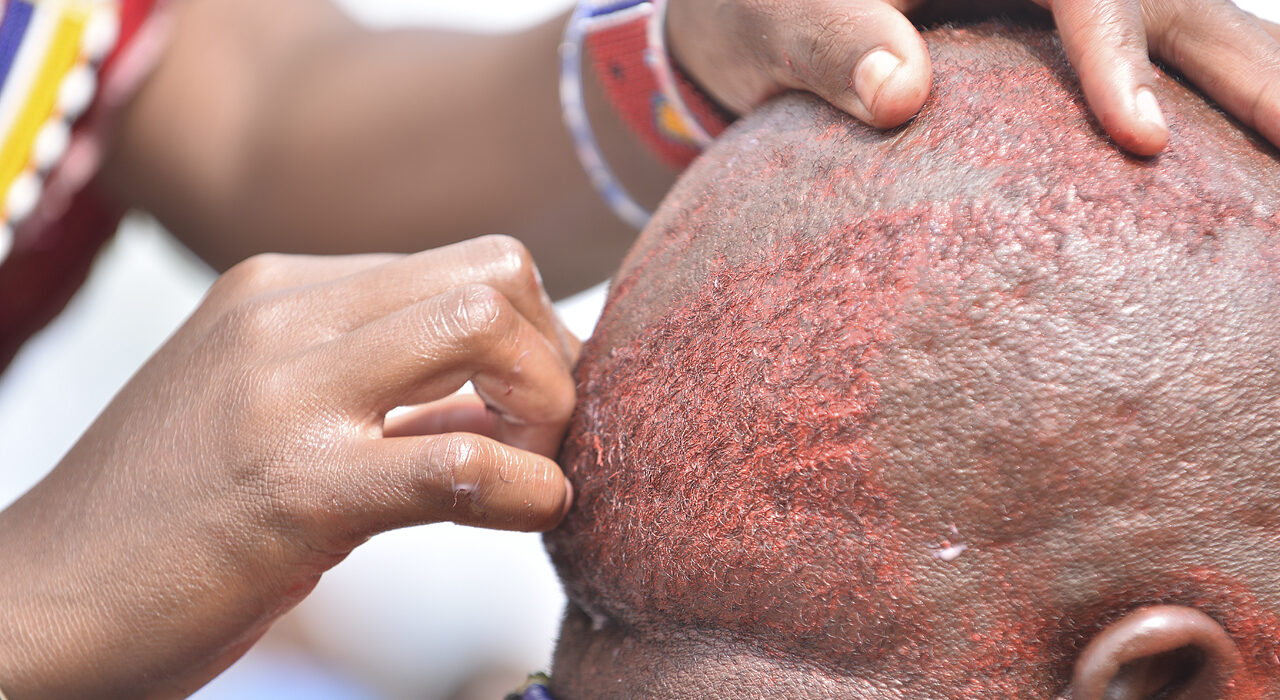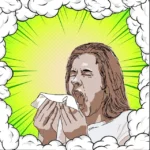Why do Cancer Patients Shave Their Heads?

On the battlefield against cancer, every victory is hard-won, and every setback is keenly felt. A seemingly ordinary behavior has far-reaching significance: Why do cancer patients shave their heads? It is the desire to “control” hair loss, reduce care requirements, and immediately get them to a more comfortable hairless place.
Imagine, if you want, facing the emotional turmoil of a diagnosis that subverts your world, threatening to deprive you not only of your health but of your sense of self.
For many cancer patients, the prospect of losing their hair under the ravages of chemotherapy is another cruel twist of fate—a tangible reminder of the disease’s control over their lives.
However, in the face of such adversity, there has been a quiet rebellion-a decision to seize control where control seems elusive and redefine beauty where beauty seems to be lost.
Therefore, the act of shaving one’s head is not just a practical necessity; it becomes a symbol of strength, resilience, and unwavering determination.
This is a statement to the world that despite the trials and tribulations of cancer, a person’s identity is still intact and unyielding in the face of adversity.
Therefore, join our journey and enter the core of this brave decision as we explore countless reasons why cancer patients shave their heads and reveal the deep depths of the human spirit.
What is cancer?
Cancer is a large group of diseases with one thing in common: They all happen when normal cells become cancerous cells that multiply and spread.
But fewer people are dying of cancer now than 20 years ago. Early detection and innovative treatments are curing cancer and helping people with cancer live longer.
Cancer is a ruthless opponent, causing serious damage not only to the body but also to the mind and spirit. This was a battle that tested the limits of human resilience, leaving a series of emotional wrecks and physical scars.
How does cancer start in your body?
Cancer starts when a gene or several genes mutate and create cancerous cells. These cells create cancer clusters or tumors.
Cancerous cells may break away from tumors, using your lymphatic system or bloodstream to travel to other areas of your body. (Healthcare providers call this metastasis.)
For example, a tumor in your breast may spread to your lungs, making it hard for you to breathe. In some types of blood cancer, abnormal cells in your bone marrow make abnormal blood cells that multiply uncontrollably. Eventually, the abnormal cells crowd out normal blood cells.
How common is cancer?
According to the American Cancer Society, 1 in 2 men and people assigned male at birth (AMAB) and 1 in 3 women and people assigned female at birth (AFAB) will develop cancer.
As of 2019, more than 16.9 million people in the U.S. were living with cancer. The most common cancers are:
Breast cancer: Breast cancer is the most common type of cancer. It mostly affects women and people AFAB. But about 1% of all breast cancer cases affect men and people AMAB.
Lung cancer: Lung cancer is the second most common cancer. There are two types of lung cancer: non-small cell cancer and small cell lung cancer.
Prostate cancer: This cancer affects 1 in 9 men and people AMAB.
Colorectal cancer: Colon cancer and rectal cancer affect different parts of your digestive system.
Blood cancers: Leukemia and lymphoma are the most common blood cancers.
The significance of hair loss in cancer treatment
Among the many tribulations faced by cancer patients, hair loss is a particularly painful symbol of their pain.
This is not just the shedding of strands, but the stripping of a person’s identity, leaving a stark reminder of the control of the disease.
Psychological effects of hair loss
Hair as a symbol of identity and femininity/masculinity
Hair has far-reaching significance in human culture and is a canvas for individuals to express their identity, femininity and masculinity. Therefore, its loss strikes the core of a person’s self-awareness and triggers a series of emotional turmoil.
Coping with hair loss during cancer treatment
The journey of hair loss during cancer treatment is full of emotional mines.
From the initial impact of the clumps in the shower drain pipe to the gradual thinning of the once lush locks, each stage presents its own series of challenges.
Emotional distress and self-esteem issues
When the mirror reflects a bald stranger, cancer patients are trying to overcome a deep sense of loss and disconnection.
The erosion of their appearance reflects internal turmoil, leading to a downward spiral of self-esteem and emotional distress.
Coping mechanism and support system
In the chaos of hair loss, cancer patients seek comfort in coping mechanisms and support systems.
Whether it is through treatment, support groups, or the unwavering support of loved ones, they can find a way to navigate the emotional maze and become stronger on the other side.
Understanding hair loss caused by chemotherapy
Mechanism of hair loss caused by chemotherapy
Although chemotherapy is a powerful weapon against cancer, it causes collateral damage to rapidly dividing cells (including those responsible for hair growth).
Toxic attacks disrupt the growth cycle of hair follicles and cause premature hair loss.
Common types of chemotherapy drugs that cause hair loss
Not all chemotherapy drugs have the same degree of hair loss. Although some, such as taxanes and anthracyclines, are notorious for causing severe hair thinning or complete baldness, others may have milder effects.
How do drugs cause hair loss?
Drugs cause hair loss by interfering with the normal cycle of scalp hair growth. In the anagen stage, which lasts for two to seven years, hair grows.
During the telogen period, which lasts for about three months, the hair rests. At the end of the telogen period, the hair falls off and is replaced by new hair.
Drugs can cause two types of hair loss: telogen effluvium and anagen effluvium. Learn more about other causes of baldness.
Telogen effluvium is the most common form of drug-induced hair loss. It usually appears within 2 to 4 months after starting the drug.
This condition causes the hair follicles to enter the resting period (telogen period) and fall off prematurely. People with Telogen effluvium usually lose 30% to 70% of their hair every day than normal 100 and 150.
What is Anagen Effluvium?
Anagen effluvium is hair loss that occurs during the anagen stage of the hair cycle when the hair is actively growing.
It prevents the normal division of stromal cells that produce new hair. This type of hair loss usually occurs within a few days to a few weeks after taking the drug.
It is most common in people who are taking chemotherapy drugs to treat cancer, and is usually severe, causing people to lose most or all of the hair on the head, as well as eyebrows, eyelashes, and other body hair.
The severity of hair loss caused by the drug depends on the type of drug and dose, as well as your sensitivity to the drug
What types of drugs can cause hair loss?
Chemotherapy drugs often cause anagen-effluvium-type hair loss. Since these drugs kill cancer cells throughout the body, they can also damage healthy cells, including hair stromal cells.
According to the American Cancer Society, hair usually starts to fall off within two weeks after starting chemotherapy and develops faster after one to two months.
Compared with patients taking only one drug, hair loss is more common and severe in patients taking a combination of chemotherapy drugs.
Chemotherapy drugs that tend to cause hair loss include: doxorubicin, cyclophosphamide, daptomycin, erythromycin, docetaxel, doxorubicin, etoposide, fluorouracil, isophosphamide, irinotecan, methotrexate, nitrourea, paclitaxel, Tamoxifen, topotecan and vinorelbine
How to treat hair loss caused by drugs?
It is important to check any medicines you take and discuss their potential side effects with your doctor and pharmacist.
When the drug you are taking does cause hair loss, the hair will likely grow on its own after you stop taking the drug.
If stopping the drug does not improve hair thinning, you may need to use dutasteride (Avodart), finasteride (Propecia) or Minoxidil (Rogaine) treatment, these drugs can slow hair loss and stimulate new hair growth. Learn more about how finasteride treats hair loss.
One technique may help prevent hair loss during chemotherapy. It is called scalp hypothermia, and it involves placing ice packs on the scalp a few minutes before and about half an hour after chemotherapy treatment.
Cooling the scalp will reduce blood flow to the hair follicles, making it more difficult for chemotherapy drugs to enter the hair follicle cells.
Cooling will also reduce biochemical activity, making hair follicles less susceptible to damage from chemotherapy drugs.
One problem with this technique is the risk of recurrence of scalp cancer, because due to the contraction of blood vessels, this area may not receive a full dose of drug treatment.
After chemotherapy, hair usually grows back quickly, but it may change its texture. In rare cases, even if treatment is stopped, the hair will remain thin.
Minoxidil can help restore slow hair. Some chemotherapy patients wear wigs or hats to hide their hair loss until their hair grows back.
The use of low-level laser equipment has been successful in hair regeneration. These devices include hats, helmets, hats, combs, and headbands.
Laser technology stimulates the scalp and hair follicles, and promotes hair growth and blood flow.
Time of hair loss during chemotherapy
The time of hair loss depends on the chemotherapy regimen and the individual’s response to treatment.
Although some people experience rapid hair loss within a few weeks of starting treatment, others may notice gradual thinning within a few cycles.
Medical reasons for shaving head
Prevent emotional distress: control hair loss
To regain a sense of control in the chaotic cancer treatment, many patients choose to take proactive measures, including shaving their heads.
By prescribing the conditions for hair loss, they restored their appearance of autonomy in adversity.
Manage practical problems: minimize shedding and discomfort
Practicality is also a factor in determining shaving. By preemptively removing the hair, the patient alleviates the pain of witnessing its gradual shedding and alleviates the discomfort associated with shedding.
Preparing for hair loss: an active way to shave
For some people, shaving their heads can be used as a preemptive measure against the emotional turmoil of impending hair loss.
By embracing baldness in their own way, they are strong for future challenges and maintain control over their appearance.
Empowerment of shaving head
Regain control of your appearance
In a world where so many feel beyond their control, shaving their heads becomes a bold proxy statement—visually reaffirming that cancer may determine their health, not their self-awareness.
Embrace baldness as a symbol of strength and resilience
Baldness is no longer a sign of disease; on the contrary, it has become a badge of honor, symbolizing resilience, courage, and indomitable human spirit.
This is a visual proof of their indomitable determination to win.
Looking for beauty and confidence other than hair
In the absence of hair, cancer patients have discovered a newly discovered beauty—a beauty that transcends the outside and radiates from the inside.
This is beauty forged in the furnace of adversity, exuding strength, courage and unwavering confidence.
Cancer Patient Support System
The role of medical service providers in solving hair loss problems
Healthcare providers play a key role in supporting cancer patients through the turbulent journey of hair loss.
From providing practical advice to providing emotional support, they are a beacon of hope in the dark.
Cancer Patient Support Group and Online Community
In the digital age, support is unlimited. Online communities and support groups provide a haven where cancer patients can share their experiences, seek advice, and find comfort in the company of others who understand their struggles.
Psychological counseling and treatment to deal with hair loss
The emotional trauma caused by cancer is deep and requires the expertise of mental health professionals.
Through counseling and treatment, patients learn to navigate the complex emotions around hair loss and become stronger on the other side.
Cultural and social views on baldness
Historical view of baldness and disease
Throughout history, baldness has been filled with countless meanings, usually a powerful symbol of illness, weakness, or divine punishment.
However, as society’s understanding of baldness undergoes a paradigm shift, these concepts are evolving.
Modern cultural representations of baldness and cancer
In contemporary culture, baldness has become a symbol of courage and contempt, especially in the context of cancer.
From bald celebrities to cancer awareness campaigns, society is gradually redefining its view of beauty and baldness.
Breaking Stereotypes: Redefining Beauty Standards
With every affirmation of shaved head and baldness, cancer patients challenge social norms and redefine beauty according to their own conditions.
They break stereotypes and prove that true beauty transcends appearance and exists in the depths of the human spirit.
Practical tips for shaving your head
Choose the right time to shave
For shaving heads, time is the key. Some people like to shave preemptively before hair loss begins, while others have to wait until the first signs of shedding appear.
Ultimately, the decision depends on personal preference and comfort.
Correct techniques and tools for shaving
Shaving your head requires skill and the right tools to do the job. From choosing the perfect razor to mastering the art of shaving cream, attention to detail is essential to achieve a smooth and perfect shave.
Skin care tips to keep your scalp healthy after shaving
A freshly shaved head deserves the same care and attention as other parts of the body. Moisturizers, gentle exfoliants, and sun protection are essential to keep the scalp healthy, hydrated, and free from irritation.
Alternative options for managing hair loss
Wig, scarf, and headwear options
For those who like to hide baldness, there are a series of options waiting for them. From fashionable wigs to vibrant scarves and headwear, cancer patients can choose from a large number of headwear, allowing them to express their style.
Scalp cooling technology to reduce hair loss during chemotherapy
In recent years, scalp cooling technology has become a promising solution to minimize hair loss caused by chemotherapy.
By reducing blood flow to the scalp, these innovative devices help protect hair follicles and retain hair during treatment.
Hair regeneration treatment after completing cancer treatment
As the final chemotherapy infusion gradually disappeared in the rearview mirror, many cancer survivors eagerly looked forward to the regeneration of their hair.
However, the journey of full hair is often a gradual process that requires patience, perseverance, and a dash of optimism.
The role of loved ones in supporting hair loss
Provide emotional support and encouragement
Loved ones play a vital role in supporting the spirits of cancer patients facing hair loss. Their unwavering support, encouragement and guarantee become a lifeline in times of doubt and despair.
Practical help with shaving and maintenance
From waving the razor precisely to gently encouraging, relatives have extended a helping hand in the difficult task of shaving their heads and keeping their scalps smooth.
Understand and empathize with patients’ feelings about hair loss
Empathy is the cornerstone of effective support. Taking time to understand your emotional roller coaster relatives can provide comfort and comfort when needed, and cultivate a sense of connection and understanding.
The journey of hair regrowth
Timeline of hair regeneration after chemotherapy
The path of hair regrowth is as unique as an individual traversing it. Although some people may experience rapid regrowth within a few months after completing chemotherapy.
Others may face a longer waiting period before seeing new signs of growth.
Management expectations: Regeneration process
Patience is the most important when it comes to hair regrowth. Understanding that regrowth is a gradual process characterized by stages of growth, rest, and shedding helps to manage expectations and alleviate setbacks.
Celebrate milestones: Embrace new hair growth
Every bud of new hair is worth celebrating as a proof of resilience, healing, and the victory of the human spirit over adversity.
By embracing these milestones, cancer survivors have returned to a sense of normalcy and happiness in their journey.
conclusion
The journey of hair loss and shaving proves the resilience of the human spirit is a story woven with courage, fragility, and unwavering determination.
This is a journey marked by loss and victory, despair and hope, but most importantly, it is a journey of self-discovery and empowerment.
When cancer patients sail in the turbulent waters of hair loss, they discover a beauty that transcends appearance—a beauty rooted in strength, courage, and unwavering resilience.
In the face of adversity, they become a beacon of hope and inspire others to embrace their journey with grace and dignity.
For all cancer patients who have embarked on this journey of change, know that you are not alone. When you experience the twists and turns of hair loss and shaving, remember that true beauty is in it, waiting to be discovered and celebrated.
Embrace your journey, including the changes in your appearance, with courage, grace, and unwavering determination, because in the face of adversity, we will discover our true strength and beauty.









